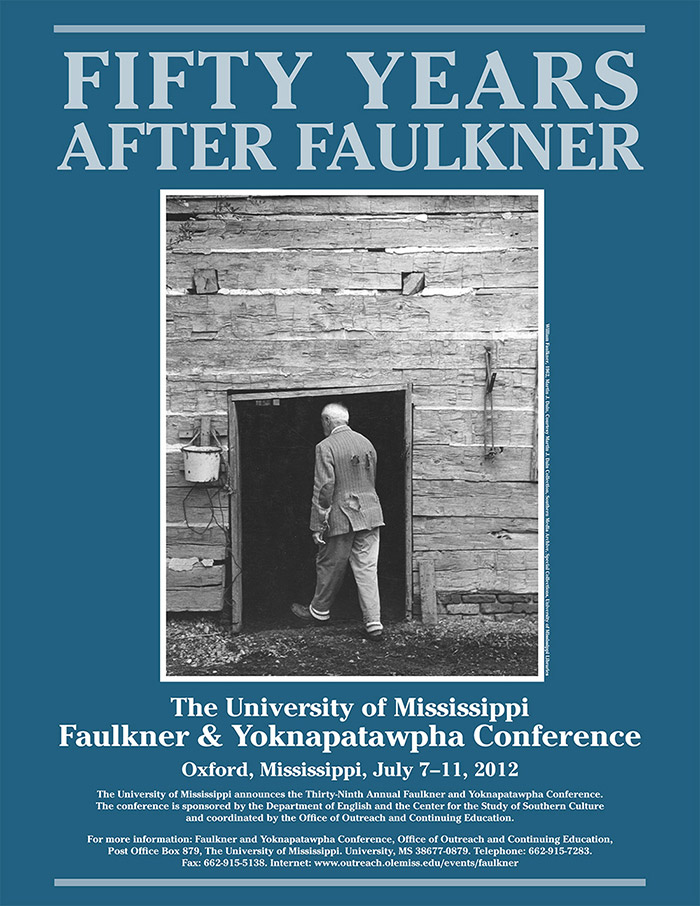
Panel. Faulkner's Afterlives
Location
Nutt Auditorium
Start Date
9-7-2012 3:30 PM
Description
- Yoknapatawpha Pulp, or “What Faulkner really read at the P.O.” / David M. Earle, West Florida University
Literary history would have it that before Faulkner lost his job at the University Post Office for holding back – and reading – patron’s magazines, he read an awful lot of high brow literature in the comparatively literary little magazine that were the main outlet for modernist literature. This paper shall consider the actual scene of magazine production in the early 1920s in order to establish how rich and extensive Faulkner’s exposure to popular literature was. Examining Faulkner’s use of pulp and confessional magazine conventions in Sanctuary, Pylon, and Wild Palms illustrates reliance upon populist forms beyond folktale and myth, and simultaneously questions the traditional idea of modernism as dependent solely on rarified magazines and restricted readers. - Late Faulkner: Afterlife, Influence, and Performance / Joseph Fruscione, Georgetown University
As his dynamic of rivalry and psychocompetitive influence with Hemingway evolved in the 1950s, Faulkner took a seemingly more relaxed stance in his late comments and works, among them “Race at Morning,” which features the character Mister Ernest. Hemingway's reaction to Faulkner's success was diametrical: namely, a series of letters, in-progress texts, and the vituperative “The Art of the Short Story”—all of which deride Faulkner’s work. Through contextual analysis of selected correspondence and texts, as well as paratextual analysis of A Fable, I will delineate how Faulkner and Hemingway assumed a performative, supra-authorial role in conjunction with each other—one that moved them from creators of literature to reviewers, framers, and sage-like critics of it. - Phillips’ Termite and Faulkner’s Benjy: What Disability / Terrell L. Tebbetts, Lyon College
This essay examines the relationship between Jayne Anne Phillips’ 2009 novel Lark and Termite and Faulkner’s 1929 The Sound and the Fury. The earliest reviews of Phillips’ work recognized the many connections between the two novels—in structure, in narration, in character, and in theme. I focus on the novels’ characters with disabilities—Faulkner’s Benjy Compson and Phillips’ Termite. Termite possesses more disabilities than Benjy. He is not only non-verbal but also non-mobile and vision impaired. Yet Termite also possesses exceptional abilities that exceed his disabilities, rendering him a precocious rather than diminished character, a human being of fullest worth. Phillips’ portrait of Termite invites Faulkner’s readers to consider Benjy anew, looking for clues to his exceptional abilities, clues that Phillips may have seen but other readers and scholars may have missed. This essay argues that Termite’s exceptional abilities are indeed rooted in Benjy’s and that Benjy emerges from Phillips’ reconsideration of disability as a character with extraordinary sensory and even extrasensory perception. Phillips’ novel, then, helps Faulkner’s readers and critics respond to disability scholars’ criticism of Benjy’s portrayal in The Sound and the Fury.
Relational Format
Conference proceeding
Recommended Citation
Earle, David M.; Fruscione, Joseph; and Tebbetts, Terrell L., "Panel. Faulkner's Afterlives" (2012). Faulkner and Yoknapatawpha Conference. 29.
https://egrove.olemiss.edu/fy/2012/schedule/29
COinS
Jul 9th, 3:30 PM
Panel. Faulkner's Afterlives
Nutt Auditorium
- Yoknapatawpha Pulp, or “What Faulkner really read at the P.O.” / David M. Earle, West Florida University
Literary history would have it that before Faulkner lost his job at the University Post Office for holding back – and reading – patron’s magazines, he read an awful lot of high brow literature in the comparatively literary little magazine that were the main outlet for modernist literature. This paper shall consider the actual scene of magazine production in the early 1920s in order to establish how rich and extensive Faulkner’s exposure to popular literature was. Examining Faulkner’s use of pulp and confessional magazine conventions in Sanctuary, Pylon, and Wild Palms illustrates reliance upon populist forms beyond folktale and myth, and simultaneously questions the traditional idea of modernism as dependent solely on rarified magazines and restricted readers. - Late Faulkner: Afterlife, Influence, and Performance / Joseph Fruscione, Georgetown University
As his dynamic of rivalry and psychocompetitive influence with Hemingway evolved in the 1950s, Faulkner took a seemingly more relaxed stance in his late comments and works, among them “Race at Morning,” which features the character Mister Ernest. Hemingway's reaction to Faulkner's success was diametrical: namely, a series of letters, in-progress texts, and the vituperative “The Art of the Short Story”—all of which deride Faulkner’s work. Through contextual analysis of selected correspondence and texts, as well as paratextual analysis of A Fable, I will delineate how Faulkner and Hemingway assumed a performative, supra-authorial role in conjunction with each other—one that moved them from creators of literature to reviewers, framers, and sage-like critics of it. - Phillips’ Termite and Faulkner’s Benjy: What Disability / Terrell L. Tebbetts, Lyon College
This essay examines the relationship between Jayne Anne Phillips’ 2009 novel Lark and Termite and Faulkner’s 1929 The Sound and the Fury. The earliest reviews of Phillips’ work recognized the many connections between the two novels—in structure, in narration, in character, and in theme. I focus on the novels’ characters with disabilities—Faulkner’s Benjy Compson and Phillips’ Termite. Termite possesses more disabilities than Benjy. He is not only non-verbal but also non-mobile and vision impaired. Yet Termite also possesses exceptional abilities that exceed his disabilities, rendering him a precocious rather than diminished character, a human being of fullest worth. Phillips’ portrait of Termite invites Faulkner’s readers to consider Benjy anew, looking for clues to his exceptional abilities, clues that Phillips may have seen but other readers and scholars may have missed. This essay argues that Termite’s exceptional abilities are indeed rooted in Benjy’s and that Benjy emerges from Phillips’ reconsideration of disability as a character with extraordinary sensory and even extrasensory perception. Phillips’ novel, then, helps Faulkner’s readers and critics respond to disability scholars’ criticism of Benjy’s portrayal in The Sound and the Fury.

